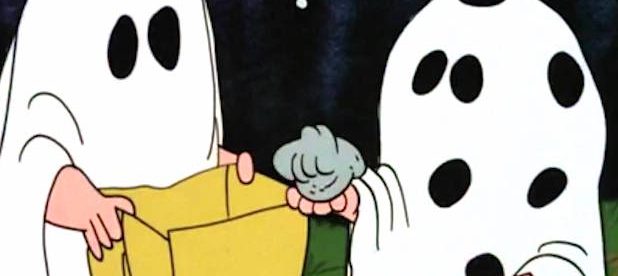Charlie Brown’s Halloween Miracle


This Thursday evening, children in dozens of countries around the world will take to the streets in costume, going door to door asking for candy. And in many cases, the residents of those houses will deliver. Upon the command “trick or treat!,” by and large, kids are greeted with the latter — often in the form of candy.
And then there’s Charlie Brown.
Charlie Brown, of course, is a major character of the long-running comic strip, Peanuts. The comic debuted in 1950 in a four-panel story, seen here; Charlie is walking down the street much to the chagrin of another child sitting nearby. Over the course of the next five decades, artist Charles Schulz would create nearly 18,000 more such comics — and a few made-for-TV specials, too. In 1966, for example, the Peanuts gang celebrated Halloween in It’s the Great Pumpkin, Charlie Brown, a 25-minute show which debuted on CBS.
The Great Pumpkin, from Charlie Brown’s perspective, goes about as well as all the other Peanuts stories, which is to say, not well at all. Charlie Brown is famous for having bad luck in almost all situations and for being the butt of others’ mean pranks. In The Great Pumpkin, viewers learn that Halloween is no different in that regard. In the story, Charlie tries to create a ghost costume for himself but gets a little too friendly with the scissors, creating more eyeholes than any ghost would never need, as seen above. And then things get worse.
The general rule is that if you trick-or-treat, you get candy, no matter how odd your costume may be. But Charlie Brown is the exception to the rule; that’s the joke, after all. So it should surprise no one that Charlie Brown’s trick-or-treating doesn’t go as planned — he didn’t end up with a lot of treats. As seen in this short clip from YouTube, while his friends get handfuls of candy, Charlie Brown gets rocks. Not once, not twice, but three times. And he gets no candy. It’s pretty easy to feel bad for poor old Charlie Brown.
And many, many people did. Shortly after The Great Pumpkin aired in October of 1966, Charles Schultz’s animation studio started getting mail from children across the nation. Not fan letters nor hate mail, though; these were notes of empathy. The studio was inundated with care packages for the fictional character, with each parcel trying to make Charlie Brown’s Halloween less of a disaster. As the Town and Country magazine reported, “sympathetic children sent Charlie Brown candy after the show aired,” sharing their haul with the kid who got none This wasn’t a one-time thing, either; CBS (and later, ABC instead) decided to air The Great Pumpkin became an annual tradition, and each year, new generations of viewers would send candy into the sweets-deprived star of the show.
Schulz, according to his daughter Jill, was amused by the fan’s support for Charlie Brown; in 2018, years after her father’s death, she told the Wrap “I remember him telling me and chuckling about it, that people were feeling bad for Charlie Brown and sending the candy.” Per Jill, he kept none for himself, sharing it with the office staff, their families, and the Charlie Browns among them, too.
Bonus fact: Throughout Peanuts’ five-decade run, Schultz drew adults very, very rarely — and only drew one with a visible face once. The Sunday, November 8, 1964 strip (seen here) features a comic-within-a-comic — Linus, one of the characters, draws the story about a little girl’s trip to the doctor. Linus’ comic includes a drawing of the (adult) doctor. (There are a few other adults whose faces appear in Peanuts, but those are either actual photographs or added by guest illustrators; Schulz drew no adult faces other than Linus’ doctor.)
From the Archives: The Broken Heart Drug: It starts with Charlie Brown.
